Stories
The Little Black Dress
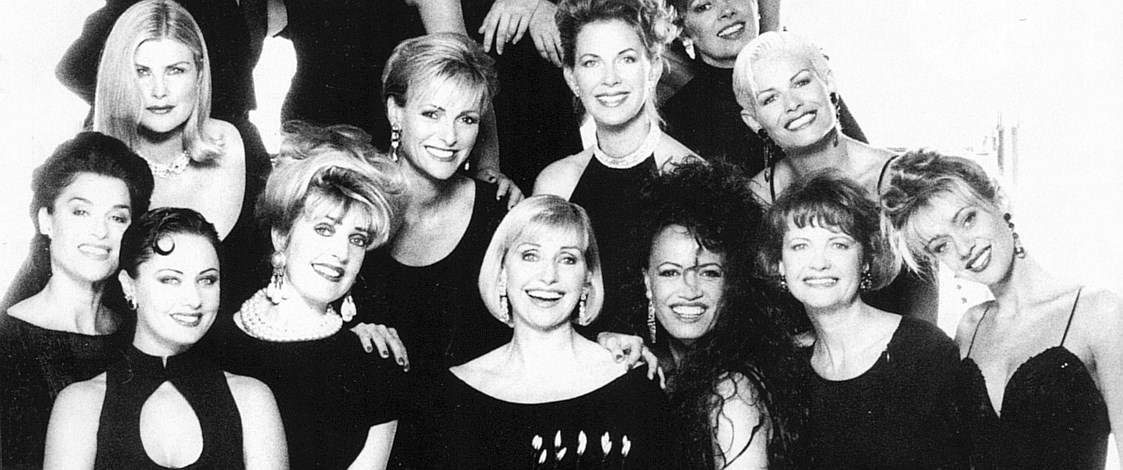
The little black dress is a fashion classic, prized for its timelessness, appropriateness and adaptability. It is fundamentally an unadorned simple dress with or without sleeves, but over time the term has become shorthand for any black dress of relatively spare proportions, long or short, embellished or not.
Most fashion historians believe Chanel to be the inventor of the little black dress as she was the first to realise its fashion potential. Although women wore black dresses prior to Chanel, for funerals and during long periods of mourning, they were a social requirement, not a fashion statement, and could never be described as ‘little’.
When Chanel introduced her first little black dress – a simple collarless crepe-de-chine sheath with a short fitted skirt and long sleeves – in 1926, her timing was perfect. The emancipated Modern Woman, who bobbed her hair, smoked 'gaspers' (cigarettes) and drank cocktails, was only too happy to reveal her figure and legs. Comparing Chanel’s dress to the Ford motor-car which was available to the masses, American Vogue predicted it would become a universally adopted uniform.
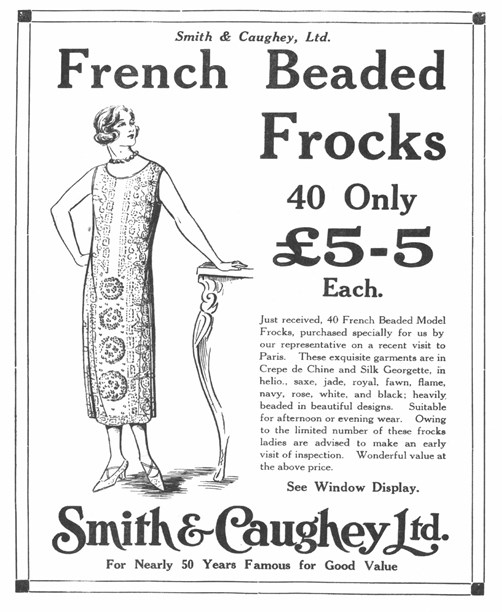
Smith & Caughey advertisement for French beaded frocks available in black and nine other colours. Auckland Star, October 1925.
By the 1930s, the LBD had come into its own, particularly for cocktail parties and formal evening events. It was a big favourite with Hollywood stars for after-five, and elements of movie magic can be glimpsed in the designs of Trilby Yates, an Auckland fashion house with a flair for using deluxe fabrics creatively.
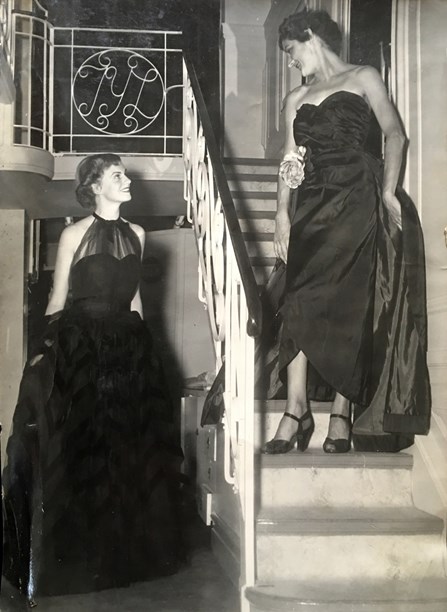
Models wearing evening dresses by Trilby Yates pose in the Trilby Yates salon, Auckland, 1930s. Image © Trilby Asgher.
Paris was another source of inspiration for New Zealand designers and dress manufacturers. A svelte black satin evening gown embellished with a spray of sequinned gold lamé flowers, created by Bruce Papas when working for Ninette Gowns in the 1940s, reflects the influence of Schiaparelli. As does a similar, but more understated dinner dress, produced in Wellington by Fashions Limited for their Fashionbilt label.
Schiaparelli-inspired black dresses by Bruce Papas for Ninette Gowns (gold flower spray) and Fashionbilt (beaded neck applique), 1940s.
Christian Dior, who deemed a 'little black frock' essential to every woman’s wardrobe, loved black so much, he said he could write a book about it. He never did write his book but he did create some of the most feminine and elegant little black dresses ever to come out of Paris. Thanks to the deal struck between El Jay’s Gus Fisher and Christian Dior in 1953, to reproduce Christian Dior originals under license in New Zealand, many of those designs became available here. Featuring structured bodices, nipped-in waists and skirts using yards of material, they were identical in every detail to the Paris originals and attainable for the well-heeled, fashion-conscious New Zealand woman.

Smith & Caughey advertisement for Christian Dior fashion parades, Auckland Star, August 1956.
A black Chantilly lace dress with a sack-back dipping into a short train, designed by Bruce Papos in 1965, recalls the creations of Balenciaga, the Spanish master of black, who invented the 'sack' silhouette. Noted for his intricate construction, Bruce Papos was named by an Auckland newspaper "the Balenciaga of New Zealand".
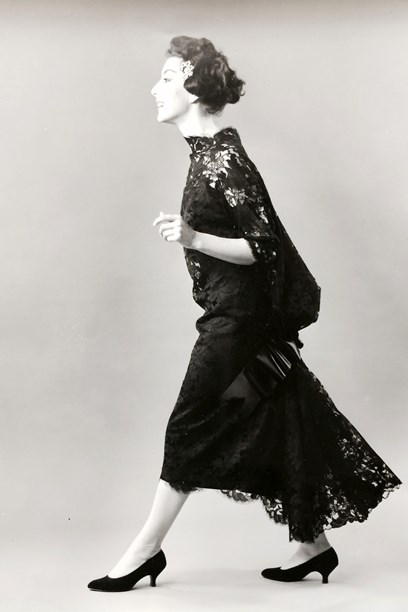
Bruce Papas Chantilly lace dress with sack-back, circa 1956.
Newspapers and local women’s magazines featured the LBD regularly in their fashion pages. Over the years, it has appeared in numerous publications, ranging from the glossy Vogue New Zealand to the modest Woman’s Choice (1954-1958), and on the covers of the New Zealand Woman’s Weekly and Fashion Quarterly. One Fashion Quarterly cover showed 15 women of style wearing little black dresses by 15 different designers. Fashion editors had fun exploiting the many moods of the little black dress – pious, imposing, soignée, sexy – or, as portrayed in a Thursday magazine spread (1975) photographed in a barren Wuthering Heights landscape with long vistas and a brooding sky, darkly Gothic.
Magazine covers featuring the little black dress (1956 and 1995).
Although it had a Bright Young Things beginning, over time the little black dress grew to acquire a sophisticated older woman image. Until the 1960s, that is, when emerging designers translated it into the mini, with varying degrees of success, and it was photographed on a new generation of youthful models by the likes of El Jay.

Josephine Brodie models an El Jay cocktail dress, 1962.
In its far-reaching movie career, the LBD played many parts. But the most endearing and enduring image is of Audrey Hepburn, in the role of Truman Capote’s party girl Holly Golightly, strolling down Fifth Avenue for her breakfast at Tiffanys in a long column of black silk designed by Givenchy. Meticulously cut and devoid of decoration, this dress and the other black dresses worn by the actress in the famous 1961 movie inspired women of all ages and served as inspiration for other designers.
The simple lines of the quintessential little black dress as expressed by Givenchy allowed no room for error. In the chic black dresses she designed for her up-market clientele, Barbara Herrick of Babs Radon also demonstrated that cut was critical. In 1963, one of her black wool crepe cocktail dresses received the Gold Medal in the Cocktail Couture category of the National Wool Awards.
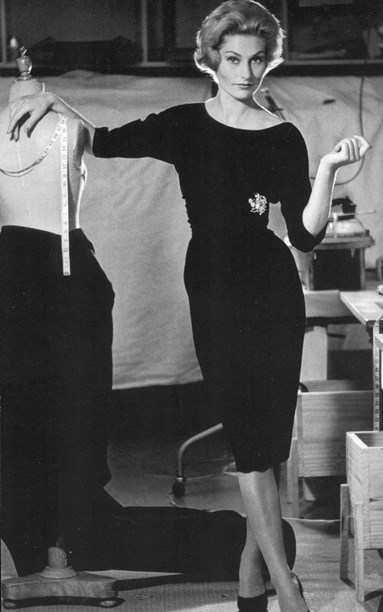
Babs Radon little black dress photographed in the Babs Radon workroom by BJ Hill, 1965.
In the 1980s, the LBD figured prominently again. Patrick Steel discloses that 90 percent of his cocktail and eveningwear was black and that he got more orders for black than any other colour. For his one-off creations, he used exclusive satins, silks, laces and velvets, imported directly or purchased from the Auckland textile house Hawes and Freer. "I generally kept my dresses all black so they wouldn’t compete with the showy costume jewellery and accessories that were the rage at the time. Big rhinestone earrings, jewelled belt clasps, beaded evening bags – a black dress really set these pieces off."
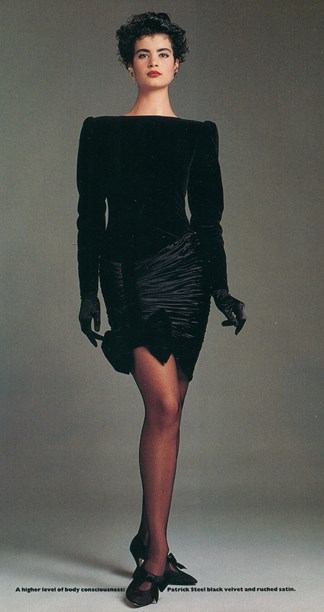
Ungaro-inspired velvet and ruched satin dress by Patrick Steel, Fashion Quarterly, Winter 1989. Photo by Tony Drayton.
The short-lived 80s’ vogue for the Christian Lacroix puffball (bubble dress) was picked up by Earlybird and interpreted in 'souffle-light black lace' while Liz Mitchell and Thornton Hall resorted to black silk taffeta and organza for party dresses with short full skirts and fabric rose trim.
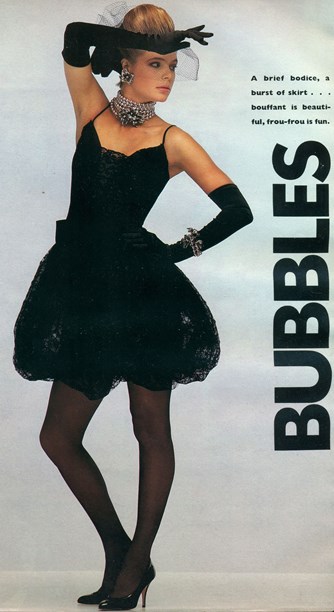
Black lace bubble dress by Earlybird, Fashion Quarterly, Spring 1987. Photo by Desmond Williams.
Chrissy Price is another former fashion designer who paid homage to the little black dress. A big fan of Chanel and Breakfast at Tiffanys, her versions were understated, reliant on classic shapes and fine fabrics such as wool crepe, chiffon, lace, sometimes beaded, and brocade, for their appeal. "My dresses were never excessively short," she says. "My favourite length was what I call the French length which just shows the under part of the knee." Chrissy had her own boutique, Quissy R, in Auckland’s fashionable Vulcan Lane.
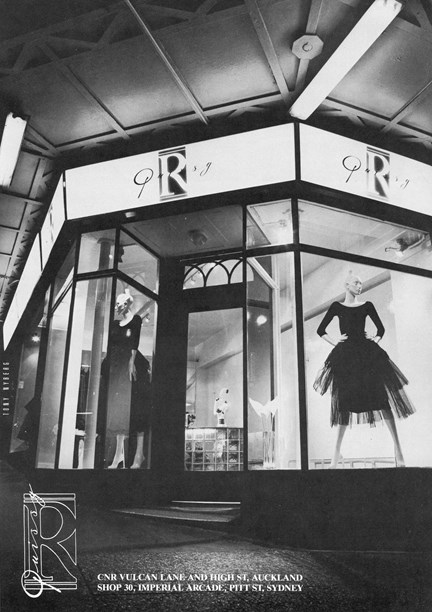
Quissy R, Vulcan Lane, Auckland 1987.
Such was the demand for little black dresses, most fashion stores stocked them. In keeping with the predominant 80s’ silhouette, the daytime version was mainly short, broad-shouldered and body-aware, with details varying from designer to designer. Rather than using cloth, Christchurch designers Nita Henry and Caroline Moore moulded the body in ultra-soft lambsuede, providing a seductive option for those who could afford it.
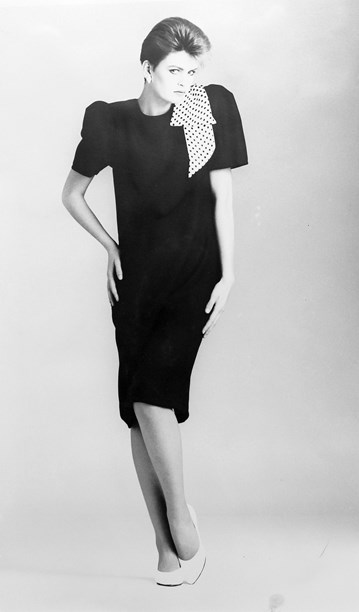
Queens day dress by Society Fashions , 1980s.
Young alternative designers, influenced, not by Paris, but by the London fashion scene, had their black dresses photographed in ChaCha, the magazine committed to street credibility and 'cool'. In ChaCha, the presentation of this image was as much a part of the style equation as the dresses themselves.

Black dress by Megan Douglas, ChaCha magazine, 1987.
Moving towards the millennium, the little black dress became more relaxed. Slip dresses, wrap dresses, and long tubular dresses in stretch fabrics replaced the edgier designs of the previous decade. A brief Sixties-revival saw the return of the shift, and flimsy dance dresses strewn with beads evoked the LBDs of the 1920s.
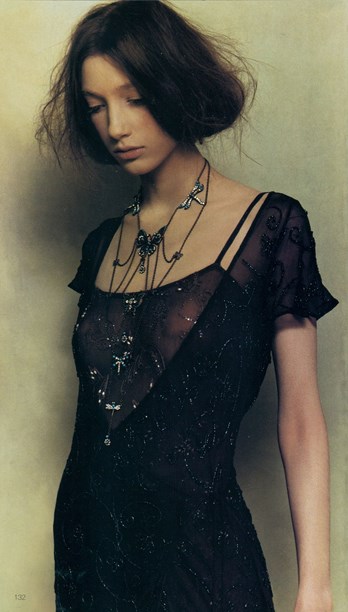
Beaded georgette dress by Karen Rielly, Fashion Quarterly, Winter 1999.
In 2002, Helmut Lang, Marc Jacobs, Ralph Lauren, Prada, practically every international designer of note showed renditions of the little black dress. The New Zealand response was more muted, but Karen Walker told Style magazine that she always had one or two black dresses in her collection. "Women come into the shop saying they want to get away from black and they end up buying it."
For most New Zealand designers at the forefront of fashion now, the inclusion of at least a couple of LBDs in their seasonal collections has become the norm. The theme of each new collection dictates the design.
Text by Cecilie Geary.
Published June 2019.